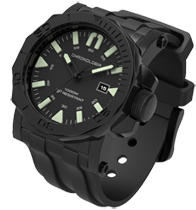Water-resistant Watch: NIHS 92-10
The water resistance of a watch is measured in bars (a unit of pressure where 1 bar equals 1 atmosphere or ATM).
Manufacturers generally indicate this water-resistance in meters (m), feet (ft), or atmospheres (ATM).
A watch described as water-resistant, with or without an additional indication of overpressure, must be conformed and tested to the criteria set out in NIHS 92-10 (equivalent to ISO-2281 international standard). Such watches are destined for ordinary everyday use, including periods of immersion in water such as leisure swimming. They can be used in conditions of changing air pressure, water pressure or temperature. However, even with an overpressure indication they are not intended to be worn for underwater diving.
Diving Watch: ISO 6425 standards
A diving watch is made to be worn underwater at a depth of at least 100 meters (330 feet). It must fully conform to the criteria set out in NIHS 92-11 standard (ISO 6425) in terms of luminosity, shock-resistance, anti-magnetism and the solidity of the strap.

Meaning a diving watch should:
- Include a time control device
- Be resistant to shock, magnetic and external forces and salt water
- Contain a device for time pre-selecting
- Be adapted to darkness (the time should be readable at a distance of 25cm of darkness and indicate that it is working in complete darkness)
- Be marked as a diver watch.
The validation of ISO requirements involves performing tests:
- The reliability test, during which the watch must resist to a 30cm underwater or 50 hours immersion.
- The resistance test: the watch must resist the 125% of the rated water pressure as well as a perpendicular force on buttons and the crown.
- The condensation test: the watch is warmed on a plate until it reaches 45?C. Then a cooler drop of water is applied on the watch; no condensation should appear into the watch.
- The Thermal Shock test: the watch is successively immersed into warm water (40?C), cold water (5?C), and warm water again. Each of the immersions lasts 10min. No water should get into the watch and no condensation should appear.
- The Water-Tightness test also permits to check that no condensation or water intrusion happens. The experiment lasts 2 hours. The watch is placed under 125% of the rated water pressure.
